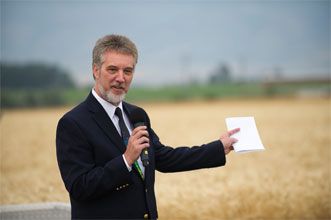All-sky Imaging of Skylight Polarization

This talk will use measurements from an all-sky polarization imager built at Montana State University, along with an experimentally validated model, to illustrate and explain how skylight polarization varies with time, location, and wavelength as a function of environmental parameters. Scattering by atmospheric gas molecules produces strongly polarized skylight, but multiple scattering by clouds, aerosols, and the underlying surface generally reduces that polarization at visible wavelengths. In the shortwave infrared, this process can be reversed, with higher aerosol content actually giving rise to a higher degree of polarization. These processes lead to a band of maximum polarization stretching across the sky at an angular location approximately 90 degrees from the Sun. This polarization pattern moves across the sky throughout the day, with a degree of polarization that varies with atmospheric and underlying surface conditions. Measurements also will be shown from the 21 August 2017 solar eclipse, during which we measured an instantaneous transition from the normal daytime polarization pattern to one centered on the zenith during totality.
Date and Time
Location
Hosts
Registration
-
 Add Event to Calendar
Add Event to Calendar
- Rochester Institute of Technology
- 54 Lomb Memorial Drive
- Rochester, New York
- United States 14623
- Building: 76
- Room Number: Carlson Auditorium
- Click here for Map
Speakers
 Joseph Shaw
Joseph Shaw
All-sky Imaging of Skylight Polarization
This talk will use measurements from an all-sky polarization imager built at Montana State University, along with an experimentally validated model, to illustrate and explain how skylight polarization varies with time, location, and wavelength as a function of environmental parameters. Scattering by atmospheric gas molecules produces strongly polarized skylight, but multiple scattering by clouds, aerosols, and the underlying surface generally reduces that polarization at visible wavelengths. In the shortwave infrared, this process can be reversed, with higher aerosol content actually giving rise to a higher degree of polarization. These processes lead to a band of maximum polarization stretching across the sky at an angular location approximately 90 degrees from the Sun. This polarization pattern moves across the sky throughout the day, with a degree of polarization that varies with atmospheric and underlying surface conditions. Measurements also will be shown from the 21 August 2017 solar eclipse, during which we measured an instantaneous transition from the normal daytime polarization pattern to one centered on the zenith during totality.
Biography:
Dr. Joseph Shaw is the Director of the Optical Technology Center at Montana State University in Bozeman, Montana. He is also Professor of Optics and Photonics, Professor of Electrical Engineering, and Affiliate Professor of Physics. For nearly three decades he has developed optical remote sensing instruments and used them to study the natural Earth environment. Dr. Shaw is a Fellow of the International Society for Optics and Photonics (SPIE) and of the Optical Society of America (OSA). He is also the author of the photo-rich book, Optics in the Air: Observing Optical Phenomena Through Airplane Windows, published by SPIE in 2017.

